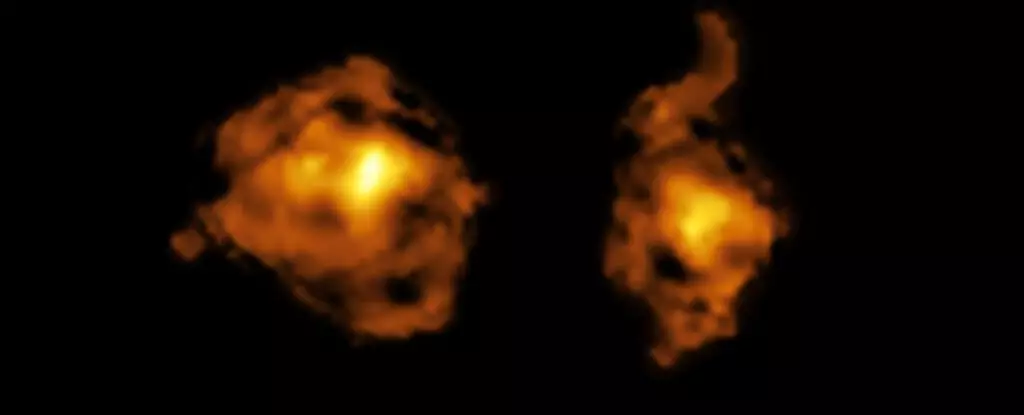Recent astronomical discoveries continue to challenge our understanding of the intricate relationships within the cosmos. Scientists have recently observed a dramatic cosmic interaction—the moment one galaxy ejects a powerful beam of radiation from its supermassive black hole into another galaxy during a merger, a phenomenon dubbed the “cosmic joust.” This event marks a groundbreaking milestone, as it provides the first direct observation of how a quasar’s radiation influences the physical structure of another galaxy. The implications of this discovery are profound, shedding light on the complex mechanisms that govern star formation and galactic evolution.
As researcher Sergei Balashev from the Ioffe Institute stated, this observation allows us to witness the direct impact of quasar radiation on an otherwise standard galaxy. It’s no longer just theoretical; we are beginning to understand the dynamic interplay at play during these massive cosmic collisions. Such galactic mergers have been theorized and examined for decades, yet this definitive evidence signifies a leap forward in our cosmic comprehension.
The Invisible Web: Dark Matter and Galactic Clusters
Galaxies do not exist in isolation; they are part of a vast, interconnected universe intricately woven by dark matter. This unseen substance acts like a gravitational web, bringing galaxies together into clusters where they collide and merge over astronomical timescales. This interaction is vital for the galaxy’s growth and the evolution of supermassive black holes, a defining characteristic of many galaxies.
Throughout history, astronomers have scrutinized galactic collisions, and the complexities involved in their interactions suggest that these processes are not merely violent occurrences. Instead, these cosmic dances are pivotal for the development of galaxies. The slow, drawn-out nature of these mergers, playing out over millions of years, creates environments ripe for new formations and cosmic adjustments. With the “cosmic joust,” we now have an exemplary case that highlights how these interactions can drastically reshape a galaxy’s star-forming potential.
The Quasar’s Role: An Explosive Influence
At the heart of this cosmic joust is a quasar, characterized as a galaxy with an exceptionally energetic black hole feeding off a substantial surrounding material cloud. This feeding process generates tremendous heat and light, peppering the universe with high-energy particles. As the quasar races past its counterpart at impressive speeds—about 500 kilometers per second—it unleashes intense jets of radiation, disrupting the star-forming gas clouds in the “wounded” galaxy.
The repercussions of this cosmic bombardment are dire, effectively suppressing the rival galaxy’s capacity for star formation. This radiation not only clears out the essential materials needed for new stars to ignite but, in a twisted turn of fate, the quasar also siphons off some of the gas from the other galaxy, feeding its own insatiable appetite. This cyclical process of destruction and consumption outlines a complex relationship where one galaxy’s growth fuels the other’s decline.
Disruption as Fertilization: The Paradox of Creation
It might seem counterintuitive, but the disruptions caused by galactic collisions often lead to the creation of new stars. As galaxies clash, their gas and dust reservoirs collide and interact; the resulting shocks create regions of high density. These areas become fertile grounds for star formation as they undergo gravitational collapse, sparking the birth of new celestial bodies. Thus, while the quasar’s aggression leads to a quenching of star formation in the galaxy it attacks, it also lays the groundwork for potential new life in the chaos that ensues.
The cosmic joust is a testament to the universe’s ability to transform destruction into renewal. Each significant interaction serves as an opportunity for rebirth, offering glimpses of how the universe continually evolves. Instead of framing these galactic encounters solely as violent confrontations, we should regard them as crucial players in the symphony of cosmic creation and destruction.
Looking Ahead: A Spacious Universe of Possibilities
As we deepen our understanding of these extraordinary celestial events, the cosmic joust serves as evidence that even the grandest forces of destruction can cycle back into creation. The vastness of the universe continues to unfold hidden narratives about life, interconnectivity, and growth. Rather than perceiving our universe as a chaotic assembly of galaxies fighting for survival, think of it as a remarkable tapestry woven with stories of interaction, transformation, and extraordinary cosmic resilience. The universe is indeed a stage where every collision could very well be a prelude to the birth of new wonders.

